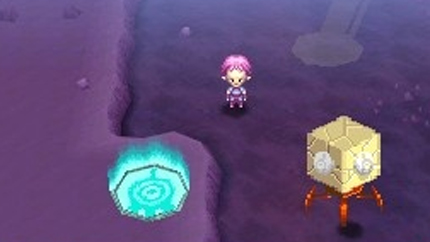Code Lyoko is a cartoon of many colors. It's made in France, looks like an anime, and features traditional 2D art and flashy CGI. The storylines float from planet-endangering digital attacks to preteen relationship drama. You would expect the game to follow a similar path by giving you tons of variety and a captivating, albeit adolescent story. Sadly, every facet of the show has received a giant downgrade in transition to video game form. From lackluster visuals and bland gameplay to an incoherent story, everything about Code Lyoko: Fall of X.A.N.A. is disappointing.
The game centers around five boarding-school students with abnormally large foreheads who live double lives as virtual superheroes in the online world of Lyoko. It's like The Matrix, except instead of agents, there are monsters powered by the evil virus X.A.N.A. This game follows the fourth and final season of the show, picking up right after the previous season ends. There are no primers to introduce you to the characters, and no tutorials to teach you how to play; it's as if the game assumes that the only people who will be playing it are hardcore Code Lyoko fans.

Like the show, Code Lyoko: Fall of X.A.N.A. is split into two different parts: the 2D world, which represents the real world that the kids live in, and the 3D world of Lyoko. Here, the 2D world exists only to let you hear the latest gossip and inside jokes from the show's characters. These sections are completely pointless and can thankfully be skipped without any detriment to the story or gameplay.
All of the real action happens in Lyoko. Once virtualized, you'll guide a superdeformed sprite around a three-dimensional world in search of switches to open doors, while battling random monsters along the way. And that's it; there are no side quests or special dungeons, just switches, doors, and monsters for nine laborious hours.
When a battle starts, the game shifts to a turn-based role-playing game, giving you control of all four Lyoko warriors. The bottom screen shows your menu choices and the top screen displays the action. After an attack has been performed, a recharge meter shows up and prevents you from attacking until it is full. The recharge length depends on the strength of the attack, so special moves will leave you waiting a bit longer. The system works well, but it isn't very challenging. Most enemies will go down within a couple of turns, and if you stagger your attacks correctly, some of your foes won't even have an opportunity to strike. If you do find yourself in danger, you can visit the laboratory to purchase healing items and attack viruses. You can also configure plug-ins, which act as modifiers to different stats. Given that the game doesn't let you spend experience points when you level up, this is as close as you'll get to customizing your characters.
Like everything else in the game, the controls aren't particularly interesting. The stylus acts as nothing more than a computer mouse, so don't expect to slash up monsters Ninja Gaiden-style. There isn't much to do outside of holding it down to guide your warrior, and tapping menus to select attacks. There are a handful of poorly executed minigames that crop up in battle, but they appear only when your character has sustained enough damage, and they do little to make the combat more engaging.
The one high point of the game lies in its multiplayer. If you have a friend who also owns the game, each of you can load up your Lyoko warriors and battle it out using a variety of options. Your warriors will have all of the items and plug-ins from your single-player saved game, so the further along that you are, the more powerful your warriors will be. In the event that your warriors are under- or overpowered compared to those of your friends, you can place various handicaps on the match. In addition to the classic battle mode, there's a challenge mode and a bet mode. The first sets a number of goals such as battling without items or using only two of the four warriors, and the second lets you wager some of your items on the outcome of the battle. Battles against a human opponent are far more intense than anything that the single-player game offers. Having to quickly manage attacks and react to a real person speeds up the combat and adds a touch of excitement not found in the rest of the game. 
Even if you're a fan of the last Code Lyoko game you'll be disappointed with the underwhelming visuals in Fall of X.A.N.A. The impressive 2D artwork is still there, but it's a waste because most of your time in the game is spent staring at a deformed representation of an already oddly proportioned character as he or she shuffles around a drab environment ripe with texture tearing and fog. The polygonal characters shown in battles fare a bit better, but they suffer from stiff animation. The effects for items and special moves look as if they were taken straight out of an early SNES game. Most of the sounds consist of digital menu bleeps and the shuffling sound of your warrior's feet. Forgettable music loops in the background add to the hypnotic boredom.
Code Lyoko: Fall of X.A.N.A. is a dull game. The absence of any real fun or challenge makes it feel less like a game and more like a chore. If you're dying for some Code Lyoko action, the 9 to 10 hours that you would spend playing this game would probably be better spent watching a marathon of the show.